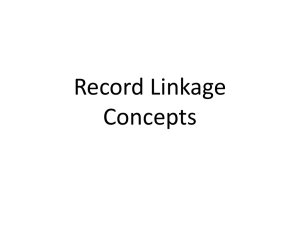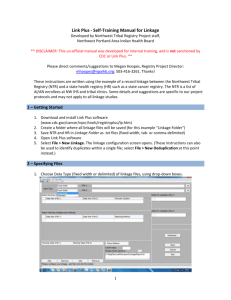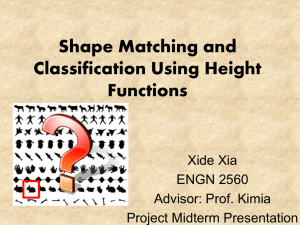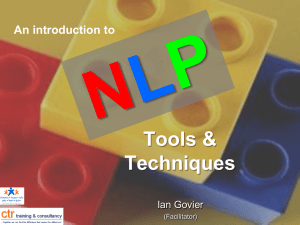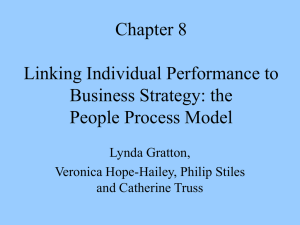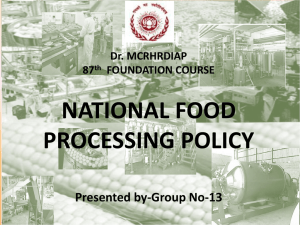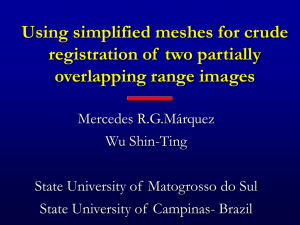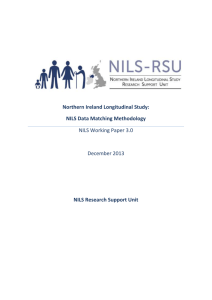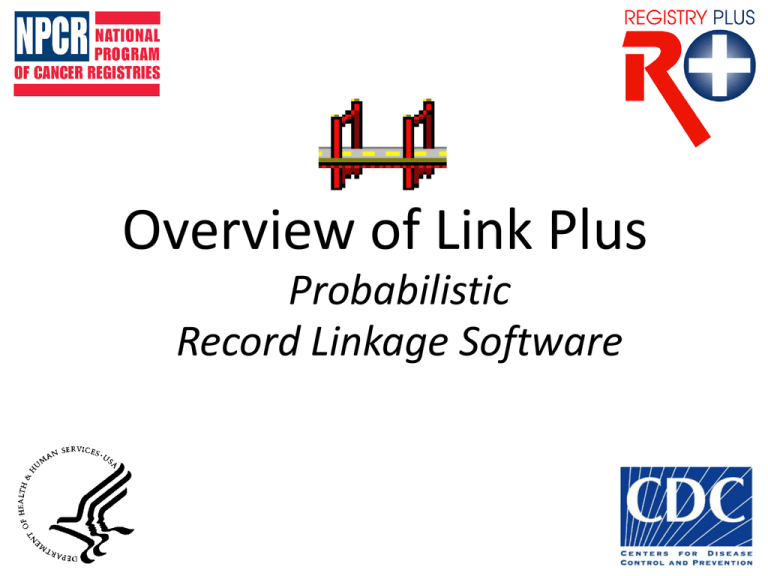
Overview of Link Plus
Probabilistic
Record Linkage Software
Acknowledgements
Slides adapted from training
materials developed by CDC–
NPCR Faculty:
• Melissa Jim, CDC/IHS
melissa.jim@ihs.gov
• David Espey, CDC/IHS
david.espey@ihs.gov
CDC/Link Plus development and
training:
• Kathleen Thoburn
• David Gu
Adapted by:
• Megan Hoopes, NW Tribal
Epidemiology Center
mhoopes@npaihb.org
Link Plus Software
• Stand-alone probabilistic record linkage program
• Combines ease of use and statistical sophistication
• Detects duplicates within a single database, or links 2
database files
• Supports North American Association of Central Cancer
Registries files, fixed width files, delimited files, and
CRS Plus database
Link Plus Software
• Can handle missing values of matching variables
– automatically treats null or empty values as missing data
and allows user to indicate additional values to be treated
as missing data
• Facilitates blocking ("OR blocking") by indexing the
variables and comparing the pairs with the identical
values on at least one of those variables
• Provides support for manual review of uncertain
matches
Link Plus Is Free
$0.00
Link Plus Is Easy To Use
Link Plus gets you from HERE:
Cancer Registry data for John Smith:
Last name
First Name
Site
SSN
DOB
SMITH
JOHN
C619
123654789
02111934
Sex
1
DateDx
06152004
Vital Statistics data for John Smith:
Last name
First Name
DOB
Date of Death
COD
Death Cert #
SMITH
JOHN
02011934
03202006
123654789
01234
Link Plus Is Easy To Use
To HERE:
Linked data for John Smith:
Last name
First Name
Site
SSN
DOB
SMITH
JOHN
C619
123654789
02011934
Sex
1
DateDx
Death Date
06152004 03202006
COD
Death Cert #
C100
01234
Link Plus Is Easy To Use
Without having to go HERE:
Link Plus Is Easy To Use
• Designed especially for cancer registry work
– HOWEVER, can be used with any data
• Mathematics largely hidden from user
• Practical default values supplied for many tasks
• Familiar Windows interface
• Includes Help and test examples
Using
Link Plus
Obtaining/Updating
Link Plus
1.
Go to NPCR Home Page:
http://www.cdc.gov/cancer/npcr
2.
In the ‘Software and Tools’ Section
- click on Registry Plus
3.
Under ‘Registry Plus Components’
- click on Link Plus - Download
Getting Started
• Make sure you know your data!
• Review and clean data files
• Frequency distributions very helpful
• Look for errant values
– e.g. - DOB day component = 16
Data Cleaning Tips
• Last Name
– Link Plus automatically cleans punctuation and strips off suffices,
numbers III
• First Name
– May find Dr. Bill or Rev Bill or Sister Mary
– Remove prefix in First Name field
• Middle Name
– Link Plus automatically cleans numbers, weird symbols
– Link Plus accounts for the switching of first and middle names
– NMI-no middle initial or NMN-no middle name
• DOB
– Review day, mo, yyyy component
– Replace errant values with missing
• Sex
– Make sure files use same coding convention; M, F, or Blank OR 1, 2,
9
Linkage Overview
Two main types of linkage:
• Linkage of 2 files
– Probabilistically link one file to another file
• Deduplication
– Special case of record linkage
– Records in the same file are blocked, compared, and
scored against each other
– Result is a ranked list of record pairs
– High-scoring pairs may be duplicates
Linkage configuration screen
File Import
File 1 versus File 2
• File 1 and File 2 have a one to many relationship
– File 1 (ONE); File 2 (MANY)
• Death record is File 1; cancer registry is File 2:
– One John Smith in death record file can link to many John
Smith’s in cancer registry file
• Cancer registry is File 1; death record is File 2
– One John Smith in cancer registry file can link to many John
Smith’s in death record file
File Layout
• After designating File 1 and File 2, specify file
layout for each file
• Link Plus reads .txt files:
– Fixed width
– Comma delimited
– Tab delimited
• Link Plus provides view of first 20 records of
each input file
– Verify that data is being read in properly
Blocking Variables
• Exact matches
• Blocks of data to compare variables within
• Common blocking variables are:
–
–
–
–
Last Name
First Name
Social Security Number
Date of Birth
Phonetic Systems
• Phonetic coding involves coding a string based on how it
is pronounced
• Link Plus offers a choice of 2 Phonetic Coding Systems:
Soundex
– Code for a name consisting of a letter followed by three
numbers: the letter is the first letter of the name, and the
numbers encode the remaining consonants
– Reduces matching problems due to different spellings
– Simple and fast
Phonetic Systems
New York State Identification and Intelligence
System (NYSIIS)
• Maps similar phonemes to the same letter; maintains relative
vowel positioning
• String can be pronounced by the reader without decoding
• Improvement to the Soundex algorithm
̶ More distinctive; people are more likely to have the same Soundex than
the same NYSIIS
̶ Reported accuracy increase of 2.7% over Soundex
̶ Studies suggest NYSIIS performs better than Soundex when Spanish
names are used
• However, Soundex may bring more pairs for comparison when
it used for blocking
Matching Variables
• Up to 10 fields may be selected for matching
• Recommended variables (Matching Methods):
–
–
–
–
–
–
–
Name--Last (LastName)
Name--First (FirstName)
Name--Middle (MiddleName)
Sex (Exact)
Race (Exact)
Birth Date (Date)
Social Security Number (SSN)
Matching Methods
• Exact
– Case insensitive character-for-character string comparison
method
– Results are either yes or no
• Generic String
– Uses edit distance function (Levenshtein distance) to compute
the similarity of two long strings
• Minimum number of operations (insertion, deletion, or substitution of a
single character) needed to transform one string into the other
• Last Name/First Name
– Incorporate both partial matching and value-specific matching
to account for minor typographical errors, misspellings, and
hyphenated names
Matching Methods
• SSN
– Specifically for Social Security Number
– Incorporates partial matching to account for typographical
errors and transposition of digits
• Date
– Incorporates partial matching to account for missing month
values and/or day values
• Middle Name
– Accounts for occurrence of the middle initial only versus the full
middle name
Matching Methods
• Value-Specific (Frequency-Based)
– Intended for advanced users
– Sets weights for matching values based on the frequencies
of values in the two files being compared
– A match on a frequent value is associated with a low weight,
while a match on a rare value is associated with a high
weight
– In a file with a high proportion of records with a white race
(value of 01), a match on value 01 would be weighted lower
than a match on the value 03 (American Indian)
Missing Values
• Automatically treats null or empty values as missing
data for Matching Variables
• Allows user to indicate additional values which are to
be treated as missing data by the program
• Specify date format on the missing value grid when
the Date Matching method is applied to a matching
variable
Missing Values
• Specify date format on the missing value grid
Direct Method
• "Direct Method" refers to the method used to derive
the M-Probabilities used in linkage
– Probability that a matching variable agrees given that a
comparison pair is a match
• Click if you prefer to use the default M-Probabilities or
user-defined M-Probabilities
• Click on Advanced to view the default M-Probabilities
or define your own
• Un-click if you prefer Link Plus to compute the MProbabilities based on your data using the EM
algorithm
EM Algorithm
• Expectation-Maximization algorithm
• Method for maximum likelihood estimation in problems
involving incomplete data
• Unclick Direct Method if you would like Link Plus to
compute the M-Probabilities based on your data
– Estimates reflect the characteristics of the data dynamically
• Very popular computational method
• Basic principle is to derive a solution in a complicated
case from a corresponding solution in a simple case
Cut Off Value
• The score value above which comparison pairs are accepted as
potential links and presented for review
• Value should always be positive
• Initial value of around 7 recommended when using the
recommended Matching Variables
• Run linkage, and quickly review potential matches to identify
upper and lower cut off scores
– Upper cut off = where do “perfect” matches end?
– Lower cut off = where do non-matches begin?
Example:
– Solid matches somewhere between 20-30
– Non-matches 10-20
– Solid = 27 and higher, and Non-matches = 17 and lower
– Gray Area = Greater than 17 and less than 27
Manual Review
of Uncertain Matches
Manual Review
of Uncertain Matches
• Once Cut Off scores have been identified
Manual Review
of Uncertain Matches
• Manual review screen provides special sorting that
always keeps the comparison pairs together
• Fields that are not on the linkage report can be included
for manual review
• Users can switch between the two viewing modes: the
Datasheet View and the Pair view
• Match status may be assigned manually, or may be
assigned automatically by match score
Manual Review
of Uncertain Matches
• Includes the option to restrict view to only uncertain
matches
• Individual columns may be sorted, hidden and unhidden
from view, and re-sized
• Order of the columns on the review screen may be
modified
• Review sessions may be saved and re-opened at a later
time
• Allows two reviews to be compared so that the
difference can be resolved into a final review file
Tips for Manual Review
• Focus initially on SSN and DOB
– Names have a lot of issues (spelling and spacing)
• Once matches on SSN go away, pay attention to DOB, name, and sex
– First and middle name switches are common
• Use race & address variables if available
• First time you start doubting if a pair is a match
– Score will be upper cut off score
– Anything above is considered a match
• When start to see junk
– Score will be lower cut off score
– Anything below is considered a non-match
• Keep an eye out for
– Husbands and wives matching (SSN’s match/sex different))
– Brothers, sisters, and twins (LN match, SSN off by 1)
• Two people should review so that results can be combined and resolved
• These are suggestions - need to know your own data
Helpful Link Plus Tips
• With real data Link Plus may take awhile to read data
files
• Be patient - Linkage times vary
– IHS Linkage (2.4 million records)
With VS Data:
• Oregon: 2 hrs/400,000 recs
• Michigan: 6.5 hrs/1,207,000 recs
With Cancer Registry Data:
• Oregon: 36 min/94,172 recs
• California: 13 hrs/1,935,255 recs
• Wait (but not days) – something went wrong
– Can run out of virtual memory
• Takes a lot of CPU
– Shutdown and restart computer right before linkage to clear up
as much space as possible prior to linkage
– Turn off screen saver/Close all other programs


